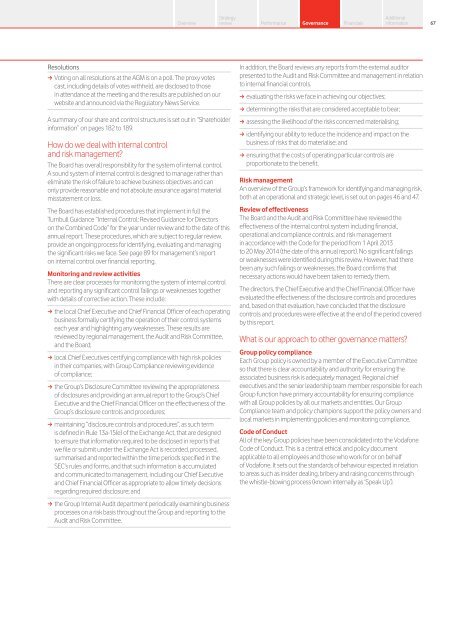full_annual_report_2014
full_annual_report_2014
full_annual_report_2014
Create successful ePaper yourself
Turn your PDF publications into a flip-book with our unique Google optimized e-Paper software.
Overview<br />
Strategy<br />
review Performance Governance Financials<br />
Additional<br />
information<br />
67<br />
Resolutions<br />
aa<br />
Voting on all resolutions at the AGM is on a poll. The proxy votes<br />
cast, including details of votes withheld, are disclosed to those<br />
in attendance at the meeting and the results are published on our<br />
website and announced via the Regulatory News Service.<br />
A summary of our share and control structures is set out in “Shareholder<br />
information” on pages 182 to 189.<br />
How do we deal with internal control<br />
and risk management?<br />
The Board has overall responsibility for the system of internal control.<br />
A sound system of internal control is designed to manage rather than<br />
eliminate the risk of failure to achieve business objectives and can<br />
only provide reasonable and not absolute assurance against material<br />
misstatement or loss.<br />
The Board has established procedures that implement in <strong>full</strong> the<br />
Turnbull Guidance “Internal Control: Revised Guidance for Directors<br />
on the Combined Code” for the year under review and to the date of this<br />
<strong>annual</strong> <strong>report</strong>. These procedures, which are subject to regular review,<br />
provide an ongoing process for identifying, evaluating and managing<br />
the significant risks we face. See page 89 for management’s <strong>report</strong><br />
on internal control over financial <strong>report</strong>ing.<br />
Monitoring and review activities<br />
There are clear processes for monitoring the system of internal control<br />
and <strong>report</strong>ing any significant control failings or weaknesses together<br />
with details of corrective action. These include:<br />
aa<br />
the local Chief Executive and Chief Financial Officer of each operating<br />
business formally certifying the operation of their control systems<br />
each year and highlighting any weaknesses. These results are<br />
reviewed by regional management, the Audit and Risk Committee,<br />
and the Board;<br />
aa<br />
local Chief Executives certifying compliance with high risk policies<br />
in their companies, with Group Compliance reviewing evidence<br />
of compliance;<br />
aa<br />
the Group’s Disclosure Committee reviewing the appropriateness<br />
of disclosures and providing an <strong>annual</strong> <strong>report</strong> to the Group’s Chief<br />
Executive and the Chief Financial Officer on the effectiveness of the<br />
Group’s disclosure controls and procedures;<br />
aa<br />
maintaining “disclosure controls and procedures”, as such term<br />
is defined in Rule 13a-15(e) of the Exchange Act, that are designed<br />
to ensure that information required to be disclosed in <strong>report</strong>s that<br />
we file or submit under the Exchange Act is recorded, processed,<br />
summarised and <strong>report</strong>ed within the time periods specified in the<br />
SEC’s rules and forms, and that such information is accumulated<br />
and communicated to management, including our Chief Executive<br />
and Chief Financial Officer as appropriate to allow timely decisions<br />
regarding required disclosure; and<br />
In addition, the Board reviews any <strong>report</strong>s from the external auditor<br />
presented to the Audit and Risk Committee and management in relation<br />
to internal financial controls.<br />
aa<br />
evaluating the risks we face in achieving our objectives;<br />
aa<br />
determining the risks that are considered acceptable to bear;<br />
aa<br />
assessing the likelihood of the risks concerned materialising;<br />
aa<br />
identifying our ability to reduce the incidence and impact on the<br />
business of risks that do materialise; and<br />
aa<br />
ensuring that the costs of operating particular controls are<br />
proportionate to the benefit.<br />
Risk management<br />
An overview of the Group’s framework for identifying and managing risk,<br />
both at an operational and strategic level, is set out on pages 46 and 47.<br />
Review of effectiveness<br />
The Board and the Audit and Risk Committee have reviewed the<br />
effectiveness of the internal control system including financial,<br />
operational and compliance controls, and risk management<br />
in accordance with the Code for the period from 1 April 2013<br />
to 20 May <strong>2014</strong> (the date of this <strong>annual</strong> <strong>report</strong>). No significant failings<br />
or weaknesses were identified during this review. However, had there<br />
been any such failings or weaknesses, the Board confirms that<br />
necessary actions would have been taken to remedy them.<br />
The directors, the Chief Executive and the Chief Financial Officer have<br />
evaluated the effectiveness of the disclosure controls and procedures<br />
and, based on that evaluation, have concluded that the disclosure<br />
controls and procedures were effective at the end of the period covered<br />
by this <strong>report</strong>.<br />
What is our approach to other governance matters?<br />
Group policy compliance<br />
Each Group policy is owned by a member of the Executive Committee<br />
so that there is clear accountability and authority for ensuring the<br />
associated business risk is adequately managed. Regional chief<br />
executives and the senior leadership team member responsible for each<br />
Group function have primary accountability for ensuring compliance<br />
with all Group policies by all our markets and entities. Our Group<br />
Compliance team and policy champions support the policy owners and<br />
local markets in implementing policies and monitoring compliance.<br />
Code of Conduct<br />
All of the key Group policies have been consolidated into the Vodafone<br />
Code of Conduct. This is a central ethical and policy document<br />
applicable to all employees and those who work for or on behalf<br />
of Vodafone. It sets out the standards of behaviour expected in relation<br />
to areas such as insider dealing, bribery and raising concerns through<br />
the whistle-blowing process (known internally as ‘Speak Up’).<br />
aa<br />
the Group Internal Audit department periodically examining business<br />
processes on a risk basis throughout the Group and <strong>report</strong>ing to the<br />
Audit and Risk Committee.


